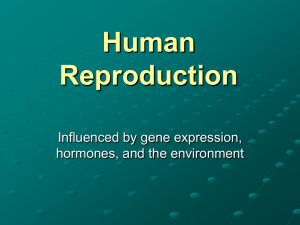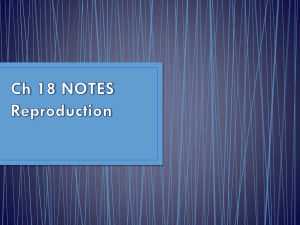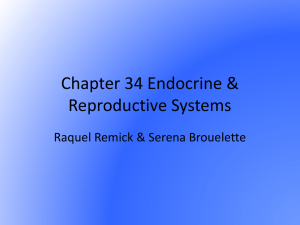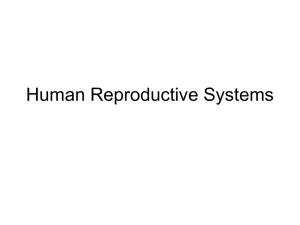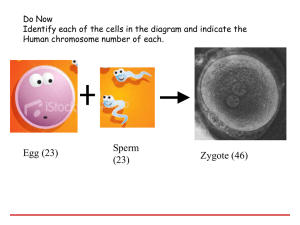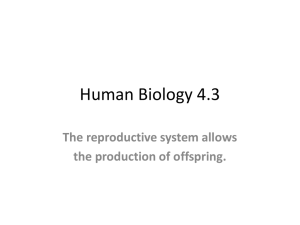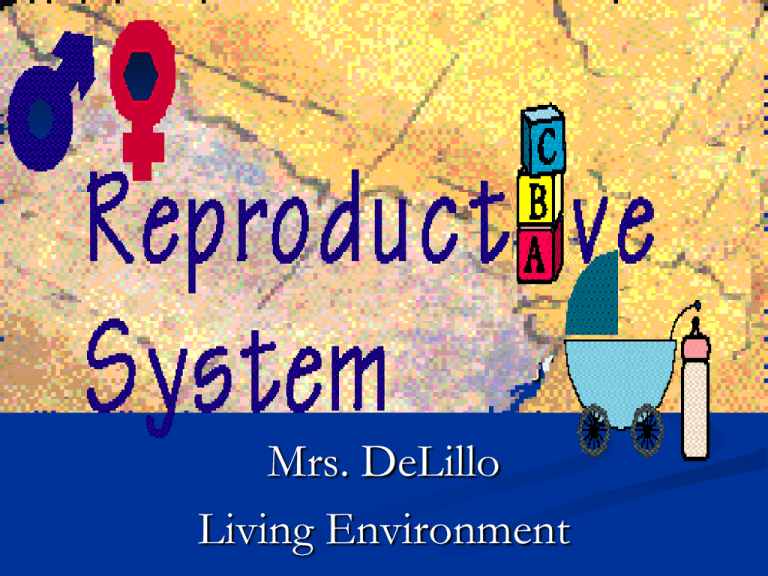
Human Reproduction
Mrs. DeLillo
Living Environment
3/17 Aim: How are males adapted
for reproduction?
Do
now: How many sperm are
produced during meiosis? How do
they compare to the parent cell in
terms of chromosome # and
appearance?
HW: Diagram handout
Test signed
Reproduction
The formation of new individuals.
Not necessary for the survival of the
individual
Necessary for the survival of the
species.
3/10 How is the male adapted to
carry out reproduction?
Do
now: How many sperm cells are
produced during spermatogenesis?
How do they compare in terms of look
and # of chromosomes to the parent
cell?
HW: Handout
Gametes:
specialized sex cells
Fusion of sperm and egg forms a
zygote.
Zygote = single cell
from which all cells
of the human body
develop.
Development
1st six weeks=male and female embryos
are identical in appearance.
During 7th week the primary
reproductive organs begin to develop
Testes = male produce testosterone
Ovaries = female produce estrogen
and progesterone
Testosterone
Responsible for the
production of sperm.
Responsible for
producing male
secondary sex
Characteristics
What characteristic is this cartoon
implying that testosterone is
responsible for?
Hair
Ovaries
Estrogen
is responsible for the
developing eggs.
Progesterone is responsible for the
production of secondary sex
characteristics
Progesterone also readies the uterus
for an embryo
Ovary
Puberty
Period
of rapid
growth and sexual
maturation during
which the
reproductive system
becomes fully
functional.
Ages 9-15 (about a
year earlier in
females)
Male Reproductive System
Main
Structures
Testes, epididymis, vas
deferens, urethra and penis
All work together to
produce and deliver sperm.
Testes
Located in the scrotum
Outside the body because the cooler
temperature is better for sperm
production.
Within the testes are the seminiferous
tubules= location of sperm
production
Sperm
Three
parts
Head with a nucleus
Mid piece with mitochondria
Tail which moves the sperm forward
Allows it to swim through the
female reproductive tract.
Sperm
Sperm Pathway
Testes
To
the epididymis to mature and be
stored
Some sperm swim into the vas deferens
Into the urethra (tube which leads to
the outside of the body through the
penis)
Sperm cont.
Swim
in seminal fluid
Produced by the glands such as
prostate that line the reproductive
tract.
Sperm + seminal fluid = semen
Between 50 and 130 million sperm
present in 1 mL of semen
Sperm Release
Autonomic
Nervous system preps the
male organs
Ejaculation: sperm are ejected from
the penis due to the contraction of
smooth muscles lining the reproductive
tract.
Not completely voluntary
2/14 How is the female adapted to
carry out reproduction?
Do
now: How many functional eggs
are produced in oogenesis? How do
they compare to the parent cell in
terms of look and # of chromosomes?
HW: Study for quiz tomorrow on male
and female reproduction
Female Reproductive System
Widening
of the hips, development of
breasts play a role in this system.
Main Structures
Ovaries, fallopian tubes, uterus and
vagina
Female Reproductive System
Prepares
the body for
nourishing an embryo
Produces eggs
Ovaries
2 present in the female
Produce 1 mature ovum/egg between
them per month.
Egg Development
Each
ovary contains 400,000 immature
eggs
Primary Follicle= clusters of cells that
surround an egg
Help the egg mature for release into
the reproductive tract where it will
become fertilized.
Egg Development
A
female will not produce any new
eggs during her lifetime
Only 400 eggs will be released in her
lifetime.
http://health.howstuffworks.com/human-reproduction4.htm
Where do the eggs develop?
Egg
is released in a process known as
ovulation
Follicle breaks open and the egg goes into
the fallopian tube aka: oviduct
The egg moves along the fallopian tube
due to cilia
It is here where it will become fertilized.
OVULATION
After
a few days, the egg is dropped into
the uterus.
If it becomes fertilized (by sperm) then the
lining is known as the cervix
Beyond the cervix is the vagina which
leads to the outside of the body
2/16
Aim: How can we describe the
stages of the menstrual cycle?
Do now: Where does fertilization
usually occur?
HW: Finish handout and regents
questions on menstrual cycle
Menstrual Cycle
Endocrine
and Reproductive Systems
interact in a series of periodic events
known as the Menstrual Cycle.
Cycle takes an average of about 28 days
Regulated by hormones controlled by
negative feedback.
Menstrual Cycle
Egg
develops and is released from the
ovary
If fertilized after ovulation it is
implanted in the uterus and embryonic
development begins.
If not it is shed along with the uterus
lining (period)
4 Cycles
Follicular Phase
Estrogen level is low
Hypothalamus tells the Pituitary to release
FSH and LH
These hormones travel to the ovaries and
cause the follicle to mature
Cells around the egg produce estrogen
because estrogen is what prepares the uterus
Thickens the lining to receive the egg
10 days long
4 Cycles
Ovulation
Shortest
phase in the cycle
Lasts 3-4 days long
Occurs midway through
Pituitary produces a sudden rush of
FSH and LH
The follicle ruptures and the mature
egg is released into the fallopian tube.
4 Cycles
Luteal
Phase aka Corpus Luteum Stage
Begins after the egg is released
Follicle turns yellow due to the rupturing
of the cells
Now known as the corpus luteum
(yellow body)
Estrogen is released and progesterone
begins to be released as well.
Luteal
4 Cycles
Phase cont.
The increased estrogen levels occur
during the 1st 14 days which promotes
cell growth and tissue development.
Blood supply increases which helps the
tissues mature
The lining is fully prepared to accept a
fertilized egg.
During the first 2 days of this phase the
fertilization rate is the highest.
If fertilized egg will begin to divide.
What happens if fertilization doesn’t
occur?
Menstruation
Within
2-3 days of ovulation, the egg
will pass through the uterus without
implantation
Corpus leuteum will disintegrate
Hormone levels in the blood
decrease.
When
the level of estrogen drop below
a certain point, the lining of the uterus
begins to detach from the uterine wall.
This tissue, along with blood and the
unfertilized egg are discharged through
the vagina.
This is known as Menstruation
Lasts 3-7 days
Day 1-5 of the cycle
A
few days later after “Period” ends,
the hormone levels are low enough to
stimulate the release of FSH and LH
The cycle begins all over again.
Do
3/17
Period 2 & 4
Aim: How can we review the
menstrual cycle?
now: Take out HW, work on
questions
HW: School island due Friday
3/17 Period 8
Aim: How can we review the
menstrual cycle?
Do
now: Take out HW (purple
questions) and labeling handout (Blue)
HW: Menstrual Cycle Questions
(Regents)



